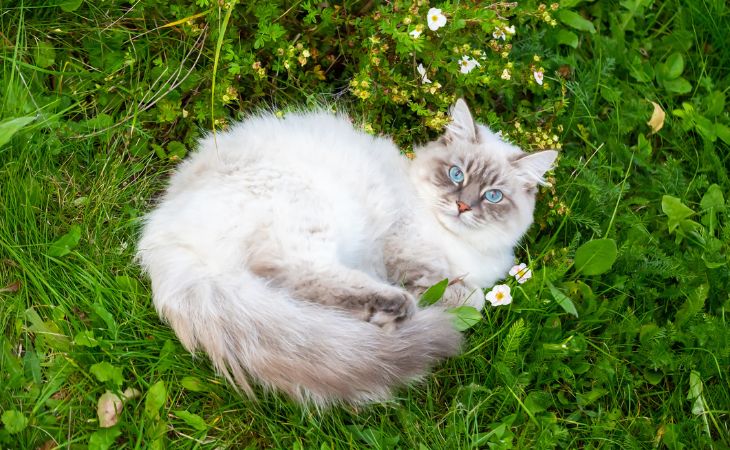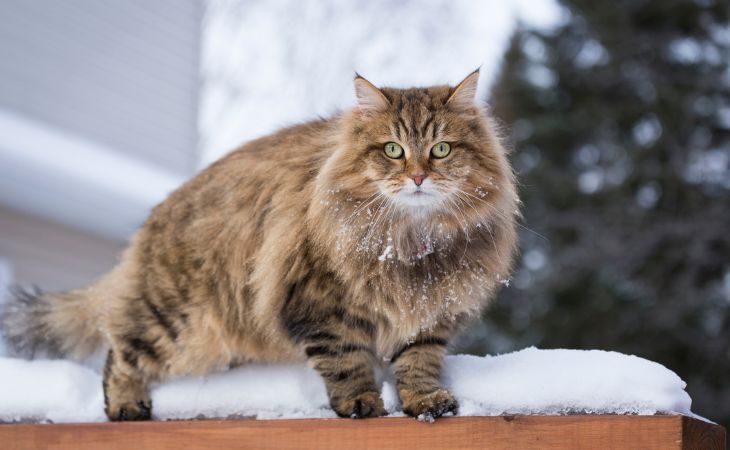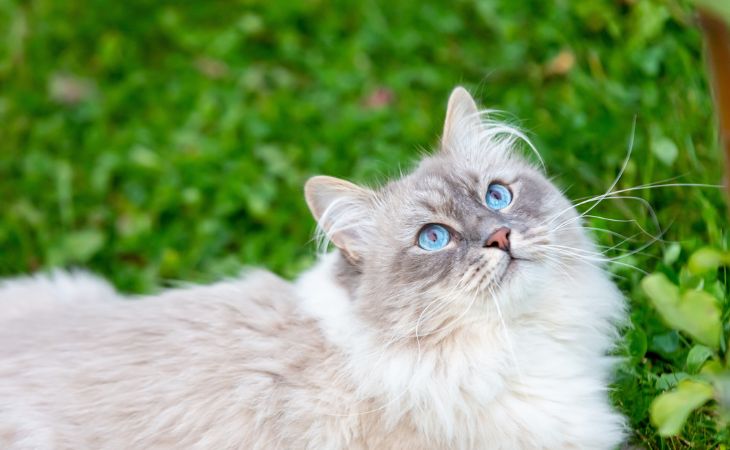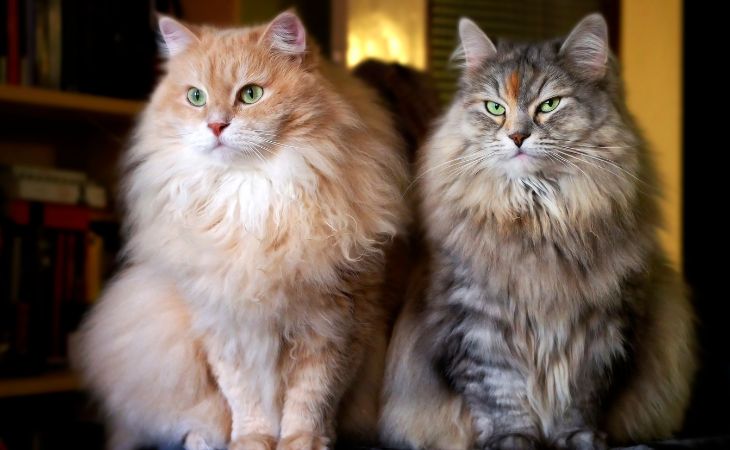Breed: Siberian | Size: Medium or large | Average lifespan: 15+ years | Temperament: Affectionate, playful, and sociable | Coat: Semi-long and long | Origin: Russia.
Siberian cats are large cats that originated in Russia. They are affectionate, playful, and easy-going fur balls. They are ideal playmates.
The origins of the Siberian cat
As its name suggests, the Siberian cat comes from Russia, and more precisely from Siberia. This cat breed arrived in Europe during the second half of the 1980s, at the end of the Cold War. It is one of the most popular cats in Europe.
A breed that appeared without human intervention
This breed is thought to be the result of breeding wild cats from the Central Siberian Plateau and the Ural Mountains with domestic cats. In Transcaucasia, there are still wild cats that closely resemble the Siberian.
A renamed breed
Cats of this breed were called “Siberian Forest Cats” but became “Siberian cats” in order to differentiate them from Norwegian Forest Cats. This breed was officially recognized in 1992 by the International Feline Federation (FIFé). However, it wasn’t until 2000 that the Cat Fanciers’ Association (CFA) recognized this breed. Then later in 2006, the CFA authorized the Siberian cat to participate in cat shows.

The character of the Siberian cat
What are the Siberian cat’s qualities?
Despite the Siberian cat’s hunting instincts, this breed is very sociable by nature. One of its highly prized qualities is that it is hypoallergenic. It produces few proteins, such as FEL D1, which can cause allergies. So it’s ideal for people who are allergic to cats, but still want a feline companion.
As they are intelligent and curious, they are particularly fond of communicating with their owner. They are always very loyal to them. In addition, they are very attached to their owners, following them around and playing with them to exercise. It is a demonstrative cat that likes to communicate. With that being said, this loyal feline is not clingy.
It is a breed that learns quickly and lets themselves get educated easily. For example, from a young age, they can learn to use the doorbell at the front door, open, or open a sliding door and closet. The Siberian can learn the rules of the house quickly. They love climbing and moving. They also like playing with children and are not against the presence of other animals like a dog.
This cat can spend long periods of time outside because of their primitive instincts, and they can do this without getting cold thanks to their superb coat.
Furthermore, they adapt very quickly to change. So, unlike other cat breeds, they can come with you on vacation. They are not very attached to routines.
What are the downsides of having a Siberian cat?
As Siberian cats are adventurous, they like to walk and frolic outdoors. Rain showers or even snow won’t dampen their appetite for walks. They may also occasionally escape into the neighbors’ gardens. Because of this, vigilance is essential. Moreover, they like to play with anything that interests them. For this reason, it’s a good idea to keep your jewelry out of this clever feline’s reach.

The Siberian cat’s physical characteristics
This giant cat with a large fur coat is very appreciated in Russia and Europe. Here are a few characteristics that make the Siberian cat unique.
General
The Siberian cat is a magisterial cat with well-developed muscles. They grow slowly and become mature around 5 years old. This cat is medium to large, and the females are smaller than the males. This domestic feline can measure up to 35 cm high and weigh around 12 kg (≈ 26.5 lb).
Head
This cat has a head in the form of a softened triangle, with a round forehead. The head is carried by a short, muscular neckline. The rather flat skull is broad, giving the head its unusual shape. Its medium-sized ears seem to point forward when viewed in profile. The tips of the ears have a lynx-like tuft.
Their large eyes are well-spaced out and harmonious with the color of their luxurious coat. They are generally a greenish-yellow. Siberians with white coats and bicolor coats can have a iris of any color (goldish yellow, green, blue, heterochromia).
Their short nose is accompanied by a round muzzle. The chin is also rounded has fur that is rather supplied.
Body
Siberians have well-developed bones and muscles. Their hips and shoulders are the same width and are supported by short and muscular legs. One of the particularities about this cat is that their hind legs are slightly longer than their front legs. Their legs end in rounded paws with tufts of hair between their toes. Their tail is thick at the base, covered in dense fur, that gets thinner around a rounded extremity.

Coat, colors, grooming, and health
Coat and colors
The Siberian has a smooth, glossy, thick and waterproof coat. Their coat is made up of semi-long and long hair and their abundant undercoat allows them to resist extreme weather conditions. This keeps them warm in winter and protects them from intense heat in summer.
The TICA (The International Cat Association) accepts all colors for the coat of this domestic feline. This is not the case of other breeding organizations that do not accept cinnamon, fawn, chocolate, and lilac coats.
Siberians with Neva Masquerade coats must have a marked mask around the eyes, and the eyes must be blue in color.
How do you take care of a Siberian cat?
The coat of the Siberian does not need particular care. Weekly brushing is enough. During molting periods, you will need to increase the frequency of the brushings. You should also think about keeping an eye on and cleaning around the eyes and inside their ears. In addition, their claws need to be trimmed every week and their ears should be checked. If they are too full, a humid cotton ball will allow you to clean it.
Their appetite is proportionate to their body size, but it’s important to keep an eye on how much they eat to avoid obesity. Their daily food ration should be high in proteins with a little carbohydrates and lipids. They can absolutely eat kibble. However, their diet should be diversified with raw meat as well as other raw foods such as offal, eggs and even fish.
Lastly, this feline likes to exercise and have space to amuse themselves. You should therefore provide a cat tree, as well an outdoor area for them.
Health
The Siberian cat is robust and does not have any particular problems with their health. They have an average lifespan of around 15 to 20 years. However, they are sensitive to hypertrophic cardiomyopathy (HCM). It is a genetic disease in which the cardiac muscle gets bigger and becomes less functional.
In addition, like other semi-long and long-haired cats, they often swallow their fur when they groom themselves. Hairballs can lead to intestinal obstructions. Therefore, they need to be regularly brushed. Cat grass is also very useful to help get rid of swallowed balls of hair.
Did you know?
Here are a few interesting facts about the Siberian cat. The Siberian cat is the national cat of Russia. They appeared in the film Nine Lives in 2016. Five Siberians were used during the filming of the film Nine Lives to play the role of Mr. Fuzzypants. Siberians like to play with water, unlike most cats.
Females mate with only one male. Males their their role seriously and invest themselves even for caring for the kittens.
The Siberian cat at a glance
Size: 35 cm.
Weight: between 4 and 10 kg (≈ 8.8 and 22 lb).
Health: Like most purebred cats, consanguinity can result in some diseases such as cardiomyopathy or hip dysplasia.
Is this breed good with children? The Siberian cat likes to exercise outside, but also enjoy the comfort of their home. They adapt easily to all environments, especially the presence of children.
Is the Siberian cat easy-going? This cat is active, affectionate, and independent. They do not have a problem interacting with other animals.

